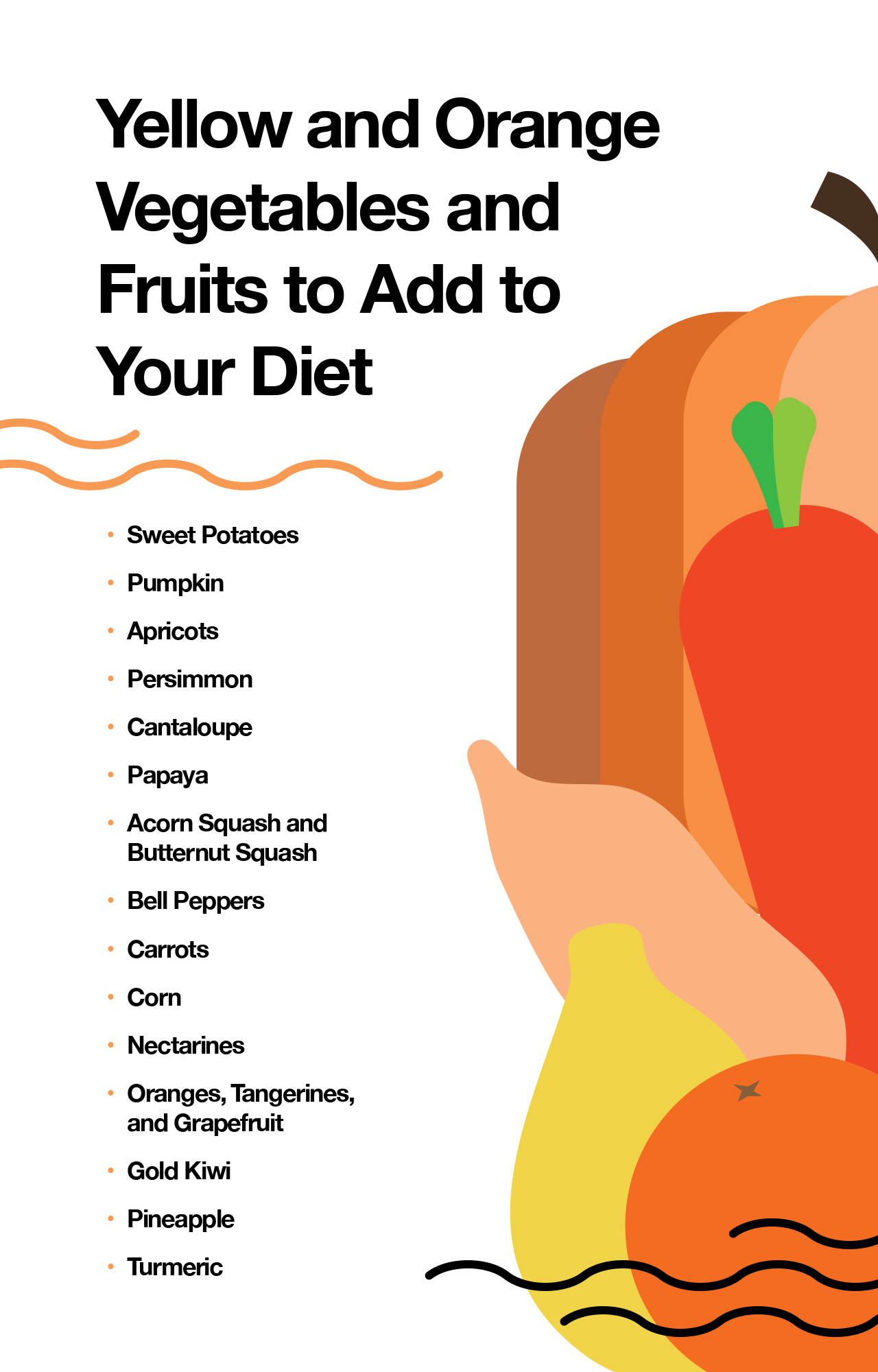Yellow and orange fruits and vegetables are pleasing to the eye and are often associated with autumn holidays like Halloween and Thanksgiving. But the pumpkins and squash that populate our doorsteps and dining room tables during the fall are good for more than just jack-o-lanterns and tasty casseroles. Did you know that the vibrant yellow and orange colors are the results of health-promoting plant pigments called carotenoids? Carotenoids function as antioxidants and have benefits for many conditions, including metabolic syndrome and fatty liver disease. Find out what yellow foods and orange foods you should be eating and how they are a critical part of a healthy diet.
What Are Carotenoids and Why Are They So Healthy?
Carotenoid pigments are phytonutrients that can be found in a variety of plant foods, particularly those that have a bright yellow or orange color. Carotenoids can be divided into three different groups of antioxidants: xanthophyll, carotene, and lycopene. Beta carotene – or vitamin A – is widely recognized for its protective effects for eye health and healing effect on vision diseases like macular degeneration. (1)
Carotenoids mitigate oxidative stress in the body. Systemic inflammation and disease processes can result in the accumulation of reactive particles in cells, which contributes to oxidative stress and the worsening of disease. Carotenoids chemically interact with these reactive free radicals, disarming them and alleviating the physiological state of oxidative stress.
Oxidative stress and inflammation play a key role in the molecular process that defines fatty liver disease. Science supports the curative effect that carotenoid-rich foods have on fatty liver disease. Researchers at the University of Wisconsin investigated the connection between carotenoid intake and fatty liver disease. (2) Results showed that higher intakes of dietary carotenoids were significantly correlated with a lower risk of having nonalcoholic fatty liver disease. (2)
Research has also shown how eating foods packed with carotenoids may also protect against metabolic syndrome. Metabolic syndrome encompasses conditions like insulin resistance, obesity, high blood pressure, and high cholesterol. Metabolic syndrome is a major contributing factor to type 2 diabetes and heart disease. A meta-analysis published in Nutrition Reviews found that a higher intake of carotenoids, especially beta carotene, was associated with a lower rate of metabolic syndrome. (3)
According to science, adding more carotenoid-rich foods to your diet can only be a good thing!
Yellow and Orange Vegetables and Fruits to Add to Your Diet
We’ve provided you a list of fruits and veggies that span the color spectrum from yellow to orange, as well as ways to make them a tasty part of your diet.
1. Sweet Potatoes
Sweet potato is of the most popular orange vegetables that are rich in carotenoids. Sweet potato is particularly rich in beta carotene and has the added benefits of other micronutrients like potassium, fiber, and vitamin C. Sweet potato can be found at the grocery store any time of the year. You don’t need to save sweet potato for the marshmallow-topped casserole at Thanksgiving dinner. Sweet potato works as an excellent addition to soups and stews, or as a side dish. The glycemic index of sweet potato is lower than that of regular white potato, meaning the carbohydrates in sweet potato are digested more slowly and don’t spike your blood sugar. For a quick carotenoid-rich side dish, microwave a sweet potato for 6-8 minutes and top with a drizzle of olive oil, garlic powder, salt, and pepper. Alternatively, you can cut a sweet potato into wedges and bake in the oven to make sweet potato fries. For extra fiber and nutrients, keep the skin on the sweet potato.
2. Pumpkin
Pumpkin is a common holiday staple used in pumpkin pies, though there are many more ways to eat pumpkin. If you’ve ever carved a Halloween jack-o-lantern, you known how time-consuming it is to open up a pumpkin and scrape out the seeds. Plus, fresh pumpkin is not always available at grocery stores. The easiest way to eat pumpkin is to use canned pumpkin puree, which can be found at grocery stores year-round. On its own, canned pumpkin is rather bitter and therefore works better when incorporated into other recipes. Try adding a scoop of canned pumpkin to smoothies with frozen bananas, pitted dates, almond milk, vanilla protein powder, and a sprinkle of cinnamon. Pumpkin can also be used as a savory addition to thick soups and stews to add an extra burst of carotenoids.
3. Apricots
Apricots are small, light orange fruits with a soft, slightly fuzzy skin. Apricots work great as portable, low-calorie snacks high in carotenoids and vitamin C. Though they’re delicious when consumed fresh, dried apricot is also tasty and nutrient-dense. Try adding dried apricots to a trail mix made of almonds, walnuts, and dried cranberries for a snack filled with healthy fats, protein, and antioxidants.
4. Persimmon
Persimmon is a hidden gem when it comes to tasty fruits with health-promoting benefits. The vibrant orange color of persimmon fruit is indicative of the carotenoid content. Persimmon is also filled with other health-promoting nutrients like vitamin C and polyphenols.
Because of its potent antioxidant activity, persimmon is also recognized for its curative effects when recovering from a hangover. To enjoy the benefits that persimmons have to offer, eat them whole, as you would an apple. Because of its unique flavor, persimmon is best consumed fresh on its own.
5. Cantaloupe
Cantaloupe is a sweet, mild-tasting fruit that contains carotenoids, as well as other phytonutrients like flavonoids that exhibit antioxidant activity. Cantaloupe works best as a refreshing snack when chilled and mixed with other fruits or when eaten on its own. Alternatively, you can prepare a cantaloupe smoothie using fresh-cut cantaloupe, ice cubes, soy milk, and a dash of cinnamon.
6. Papaya
Papaya is a tropical fruit that is filled with tons of health-promoting micronutrients, including carotenoids. Papaya has a mild flavor and is best consumed fresh or as part of a fruit salad.
As an added bonus, papaya also contains a proteolytic enzyme called papain, which operates as a digestive aid. Papain helps the body break down meat proteins into individual amino acids that can be absorbed into the bloodstream through the small intestine. The body can only utilize protein when it’s converted into its smallest units. Try incorporating papaya as a pre-meal or post-meal digestive aid, especially if meat is part of the meal.
7. Acorn Squash and Butternut Squash
Both acorn squash and butternut squash are types of winter squash that can range from yellowish to orange in color. In addition to their carotenoid content, acorn squash and butternut squash are also good sources of vitamin C and potassium.
Both types of squash have a similar texture and flavor and are usually incorporated into warm recipes, like squash soup. Both acorn squash and butternut squash can be transformed into a hearty, nutrient-dense side dish by roasting them in the oven with a drizzle of olive oil and seasoning them with salt and pepper.
8. Bell Peppers
The orange and yellow varieties of bell peppers are rich in carotenoid pigments. Bell peppers can be eaten fresh or as versatile components in a number of cooked dishes. Try slicing yellow and orange bell peppers and using them as vehicles for dips like hummus and guacamole. Sliced bell peppers and onions sautéed in olive oil and garlic make a tasty topper for tacos, salads, and sandwiches. Sautéed peppers pair well with brown rice or quinoa with black beans.
9. Carrots
Carrots seem to be a vegetable staple in many dishes, from being a star dipping agent on a vegetable platter to being added as a pop of color in chicken noodle soup. In fact, in many cuisines, chefs regard carrots as part of the “Holy Trinity,” a trifecta of vegetable ingredients that also includes onions and celery.
Carrots can be eaten raw, dipped in hummus or chopped and added as a crunchy salad topper. Try dicing carrots and adding them to your favorite soups and stews or blending them and adding them to meat sauces for extra texture and nutrients.
10. Corn
When we think of corn, we may think of corn on the cob at a barbecue or cornbread served up with a hot bowl of chili. Processed corn is also used in countless packaged items, from cereals to crackers.
Yellow corn is packed with nutritious compounds including carotenoids, fiber, vitamin C, and B vitamins. Yellow corn is in season in the spring and summer and can be eaten right off the cob. You can cook fresh corn by microwaving or boiling it. Sweet yellow corn is tasty eaten with a little bit of butter made from plant phytosterols, which have been shown to help reduce cholesterol.
11. Nectarines
Add this summer fruit to your diet for extra carotenoids and antioxidants. Here’s the catch though; only yellow-flesh nectarines contain lots of carotenoids, not the white-flesh nectarines. All nectarines, however, contain other antioxidant compounds as well, like polyphenols and vitamin C. Since nectarines are a seasonal fruit, they will be freshest and least expensive when in season, beginning towards the end of April. Sliced nectarine is a tasty topping for oatmeal and other whole-grain breakfast cereals. Nectarines also make a juicy snack on their own.
12. Oranges, Tangerines, and Grapefruit
These three fruits have been bundled because they are all categorized as citrus fruits. Citrus fruits are known for their vitamin C content, but these fruits are also rich in carotenoids and vitamin C. Additionally, oranges, tangerines, and grapefruit are all rich in fiber as well as phytochemical antioxidants called polyphenols. Flavanones are the particular type of polyphenols found in citrus fruits that fight against oxidative stress.
Did you know that the peels of oranges, tangerines, and grapefruit contain an even higher concentration of these health-protecting micronutrients? An easy way to consume the peel is by making a frozen smoothie using the whole fruit. Try tossing an entire orange into the blender with ice and a natural, low-glycemic sweetener like agave nectar.
In a pinch, store-bought orange juice with pulp is a good alternative that contains lots of antioxidant phytochemicals. However, there is one caveat; when drinking juices, keep in mind that the fiber in the whole fruit is destroyed, leaving the remaining fruit sugar and micronutrients. Without intact fiber to slow down sugar absorption, this can lead to a blood sugar spike, so drink juices sparingly.
13. Gold Kiwi
Gold kiwis are a little different than traditional green kiwis in terms of taste and texture. In comparison to green kiwis, gold kiwis are a bit sweeter, with smoother and less fuzzy skin. The gold kiwi gets its color from the presence of antioxidant carotenoids. Additionally, the gold kiwi is packed with fiber, vitamin C, potassium, and vitamin E. To enjoy a golden kiwi, simply cut in half and scoop out the fruit using a spoon. Since the skin is soft and edible, you could also eat a gold kiwifruit whole.
14. Pineapple
Pineapple is a tropical fruit with a distinct, sweet flavor. Pineapple is rich in vitamins, minerals, and antioxidants like vitamin C, manganese, potassium, and carotenes. Pineapple, because of its particularly sweet flavor, is often added as a complement to savory dishes like grilled fish.
Pineapple is an energizing summer snack, when eaten plain, but can also be a tasty part of a meat-focused meal. Additionally, pineapple contains a group of enzymes called bromelain which supports immune health, improves heart health, and supports protein digestion.
15. Turmeric
Though turmeric is better described as a spice than a food, it is packed with carotenoids that create its bright yellow hue. Turmeric has long been revered as a healing spice in traditional Eastern medicine. Science shows that turmeric is a potent anti-inflammatory agent with implications for reducing liver inflammation, promoting liver repair, fighting allergies, improving immune response, and lowering systemic inflammation. Plus, turmeric is conveniently a beautiful complement to seasonal vegetables like pumpkin, winter squash, and sweet potatoes. Try adding turmeric to pumpkin soup, squash soup, baked sweet potatoes, and roasted vegetable medleys.
Conclusion
If you’re adding more carotenoids to your diet, there are numerous tasty yellow and orange foods to choose from. Orange and yellow vegetables and fruits have many health-promoting benefits. Carotenoids exert anti-inflammatory and antioxidant effects that may help prevent and reverse fatty liver disease and metabolic syndrome. Of course, it’s important to add carotenoids on top of a balanced diet that affords optimal amounts of essential amino acids, healthy fats, fiber, vitamins, and minerals.

References:
(1) https://www.ncbi.nlm.nih.gov/pmc/articles/PMC5429337/























